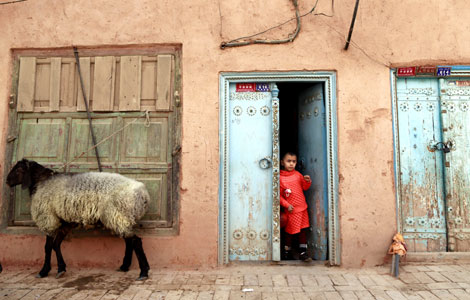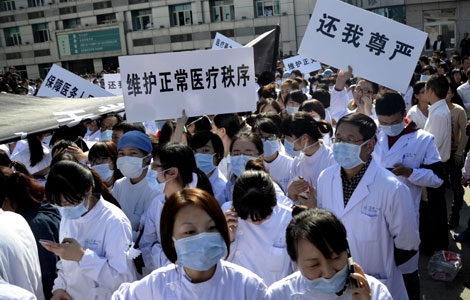Assembling a strategy for the future
Updated: 2013-11-07 06:53
By Li Fangfang (China Daily)
|
|||||||||||
Slow but stable
Earlier in 1998, IKEA opened its first store in Shanghai, and one year later the second in Beijing. However, the furnishing company suspended the expansion for five years till it inaugurated the third one in Guangzhou in 2005.
"We don't focus on short-term increases or act quickly. For Ikea, it's more important to have a good understanding of the market and customers because we see China as an important market for us to create a better life for many people," said Agnefjall.
"At the beginning, it took a long time to understand the Chinese market and customer demand. We paid visits to hundreds of homes to learn people's habits and what they needed."
After developing a stable foothold in the China market with a renowned brand representing a North European lifestyle, the Swedish company started to accelerate its retail network expansion from 2008, opening at least one new store every year.
"We are opening three new stores this year, with a third one in Shanghai and this second one in Beijing. And Ikea will have another three new stores next year," said Agnefjall.Ikea aims to have 17 stores by 2015.
Liu Jinliang, deputy secretary-general of the China National Furniture Association, said the furnishing sector in China still has a bright future.
"It's an evergreen industry in China because there is always natural demand for real estate in the long term, especially from the more than 10 million newlyweds every year," said Liu. "Rapid urbanization also drives the requirement for furniture."
According to Liu Chang, an analyst with consulting firm Roland Berger Strategy Consultants covering the retail and furnishing industries, China's furnishing market maintained an average annual growth of 11 percent between 2008 and 2011.
"It's a huge market of about 2.3 trillion yuan," said Liu. "The urbanization, newlyweds and increasing demand for a better life will help the market maintain a momentum of about 10 percent year-on-year growth by 2017."
Although it has huge potential, Liu said the industry is too segmented with many small Chinese enterprises.
"In past years, the competitiveness of furnishing companies in China was contained within product quality and distribution channels. However, discerning shoppers increasingly demand a better lifestyle and now look to branding and design," said Liu.
He said that Ikea's regional expansion to lower-tier cities will be a sustainable engine to further drive its business in China after the company's relatively conservative development in the early years played on market hunger in many places that lacked Ikea stores.
He also warned Ikea to pay attention to its strategy in first- and second-tier cities.
"The upgrading of products according to customers' increasing demand and requirements is essential to future development," said Liu.
Although there is a bright future for the domestic furnishing market, for Agnefjall, the fifth CEO of the furnishing giant, there is little more important than its retail business in China.
"Yes, we have stores in many countries. But none of them has the same importance as the China market to Ikea," said Agnefjall.
The Asian market only contributed 6 percent to the company's global revenue and China accounted for just 2 percent.
Impressively, "China is our top sourcing country, with 22 percent of Ikea's global purchasing coming from about 300 Chinese suppliers," said Agnefjall.
He said that the company's recent move of opening the first wholly- owned manufacturing facility in the country last month indicated Ikea's further determination to make China its manufacturing hub.
Located in Nantong, Jiangsu province, the factory will produce wooden products to supply Ikea stores mainly in China.With this facility, Ikea will have 43 manufacturing units in 12 countries.
"Having a wholly-owned factory helped Ikea to have a complete value chain in China, after we set up our two biggest warehouses and a test laboratory in Shanghai," said Agnefjall. "It also actively enables us in our long-term efforts to continuously cut product prices for local customers."
Providing more relevant and affordable solutions to millions of potential Chinese customers, with good-quality products at lower prices is Ikea's strategy.
It cut product prices in China by an average of more than 50 percent between 2000 and 2013.
Greener future
As the new CEO, Agnefjall is also committed to making Ikea even greener", through its sustainability strategy set for 2020.
"Ikea is likely to make a small but important contribution to society," he said.First, Ikea "should enable people to live a more sustainable life at home".
"We welcome 700 million visitors to our stores and have 1 billion online visitors every year. If we can encourage just a fraction of those to start using an induction hob or to install an LED bulb instead of a conventional light bulb, then things are taking a step in the right direction," said Agnefjall.
Disclosing that Ikea just installed its 500,000th solar panel worldwide on the roofs of Ikea buildings, Agnefjall said that the second step is that "Ikea would like to become energy-independent, which means that we will produce the same amount of sustainable energy within the group as we consume by 2020".
In July, Ikea announced it is cooperating with Chinese solar company Hanergy Holdings Group Co Ltd on a grid-connected solar power generation project for all of the Ikea stores in China as well as Ikea's selected suppliers.
The partnership will also expand to the global market because Hanergy will sell solar power generation equipment to Ikea's customers in the United Kingdom.
"That's my ambition: To create a better life for many people. It's not about selling products or business growth. It's sustainability for a positive life," said Agnefjal.
Today's Top News
China's east still the top draw for foreigners
Huawei has eye on 5G
Li: China to modernize farms
Plenum being chance for urbanization
Bigger role sought in cybersecurity
EU strives for banking union amid opposition
PE, VC investors see big returns in M&As
China reforms eye more innovative bases
Hot Topics
Lunar probe , China growth forecasts, Emission rules get tougher, China seen through 'colored lens', International board,
Editor's Picks

|

|

|

|

|

|





